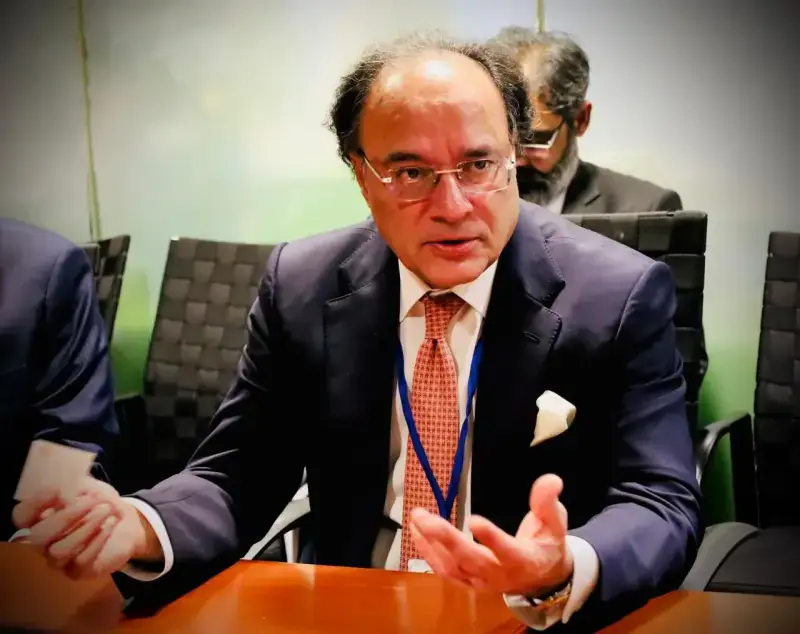Finance Minister Muhammad Aurangzeb has said that the country’s economy is showing signs of sustained recovery, backed by macroeconomic stability, progress on structural reforms, and renewed international confidence reflected in multiple credit rating upgrades.
In an interview with CGTN America during his visit to Washington DC for the IMF–World Bank Annual Meetings, Aurangzeb stated that Pakistan has consolidated fiscal and external gains, with a stable currency, foreign exchange reserves now covering around two and a half months of imports, inflation falling to single digits, and the policy rate halved compared to last year.
“All global rating agencies—Fitch, S&P, and Moody’s—have upgraded us during the course of this year, the first alignment among them in nearly three years,” he said.
Aurangzeb confirmed that the International Monetary Fund (IMF review mission recently concluded its second assessment under the Extended Fund Facility (EFF) program, leading to a staff-level agreement that underscores the Fund’s “trust and confidence” in Pakistan staying the course on reforms.
Aurangzeb briefs ADCB on Panda Bond launch, GMTN update
On the external front, Aurangzeb said Pakistan is well-positioned to meet future Eurobond obligations, with the next repayment of $1.3 billion due in April 2026.
The finance minister highlighted Pakistan’s return to commercial borrowing markets, tapping into the Middle Eastern market after a two-and-a-half-year gap. “We are now looking forward to actually printing the inaugural Panda bond before the year is out,” he said.
Highlighting past challenges on the privatisation front, Aurangzeb noted progress this fiscal year.
“Privatisation was one area where we didn’t do well, but this fiscal year we successfully concluded the sale of a small bank to a UAE conglomerate… and we are very sanguine that the national airline will be privatised before the year’s end,” he added.
Aurangzeb also spoke about Prime Minister Shehbaz Sharif’s recent visit to Beijing, which marked the formal launch of CPEC Phase 2.0.
He said 24 joint venture (JV) agreements were signed during the visit, signalling a shift from memoranda of understanding (MoUs) to JV agreements.
Aurangzeb said that the focus of CPEC 2.0 is to take the $19 billion bilateral trade volume “to a next level”.
“The second part of it is investments in all areas of mutual interest, i.e. minerals and mining, agriculture, AI and IT.
“There can be other areas around pharma.
“I think we have a huge opportunity to get the vaccination production going in Pakistan. This is one of the key areas where we can work with the Chinese enterprises to get the production going in Pakistan,” said Aurangzeb.
Pakistan plans to extend debt maturity to reduce refinancing, interest rate risks: Aurangzeb
On Pakistan’s digital transformation, the minister said the government aims to fully digitise all government payments by June next year, while expanding the use of AI and analytics to improve tax collection and transparency. He noted that technology has “played a huge role in going from 8.8% tax-to-GDP to 10.2%”.
The integration of AI and data analytics has also significantly enhanced the efficiency of tax administration.
On trade developments, Aurangzeb said Pakistan recently concluded discussions with US officials on tariff adjustments, which he believes will provide “real upside” to Pakistan’s textile exporters, especially in home textiles.
“We’re still working on the joint statement, which should be coming out soon, then the framework agreement, which is also in the works.”
Highlighting challenges, the finance minister pointed to recent flooding as a major setback to growth, which could reduce the government’s earlier GDP growth target of over 4% to around 3.5% this fiscal year.
“Climate change is an existential issue for Pakistan—we are living it day in and day out,” he said.
Concluding the interview, Aurangzeb underscored that Pakistan remains firmly committed to macroeconomic stability, structural reform, and sustainable, inclusive growth, with a clear focus on strengthening resilience, encouraging investment, and advancing the country’s long-term development agenda.


